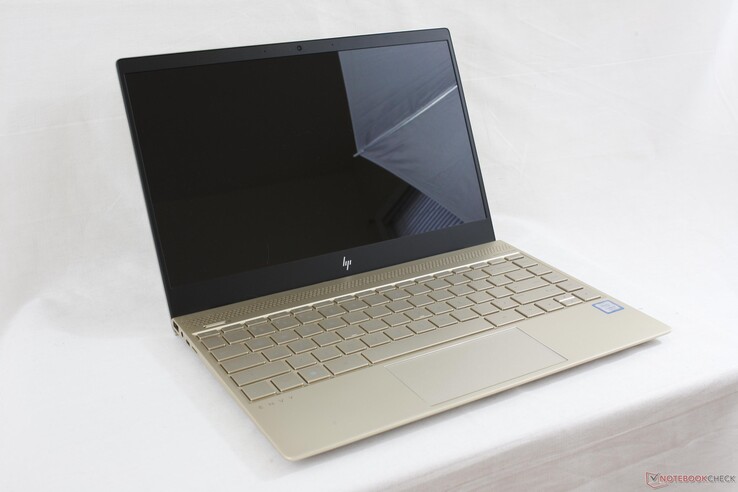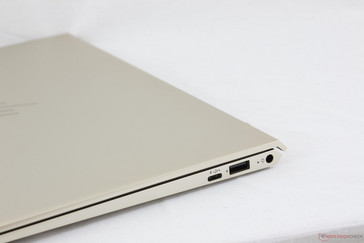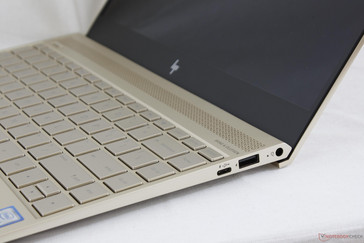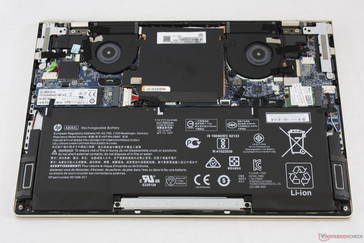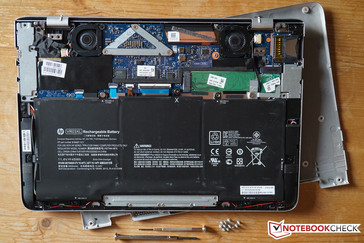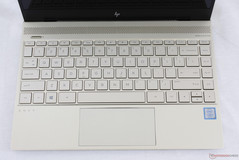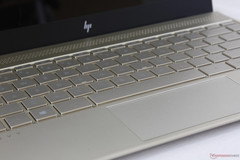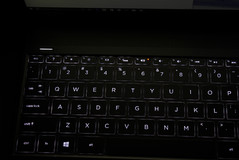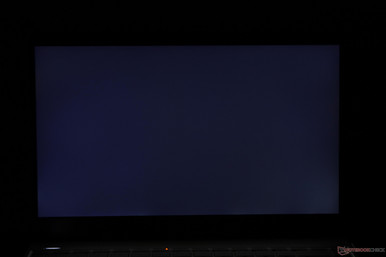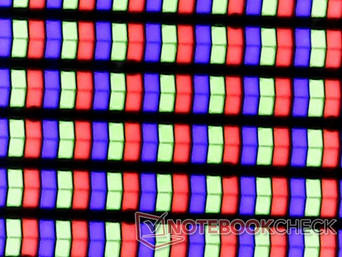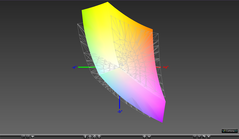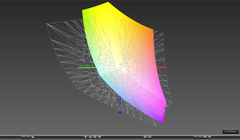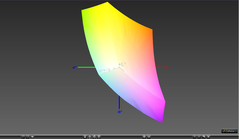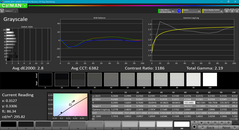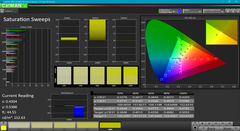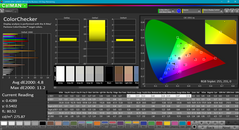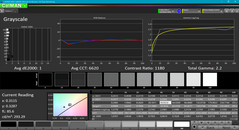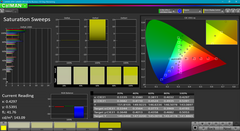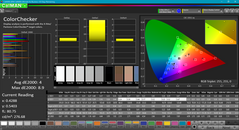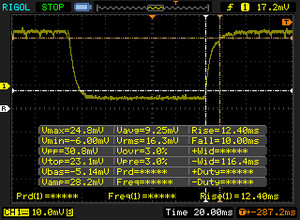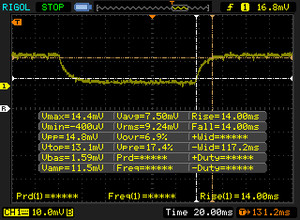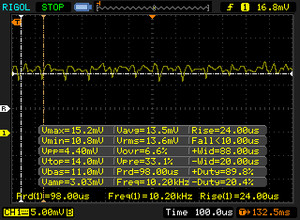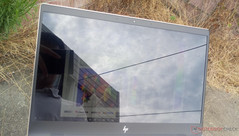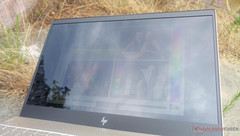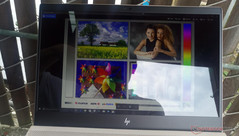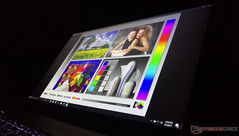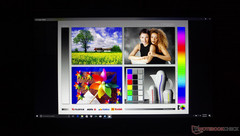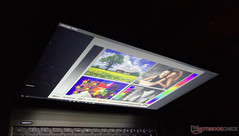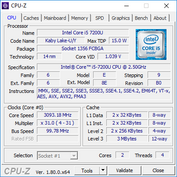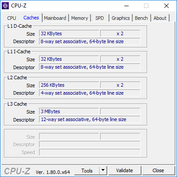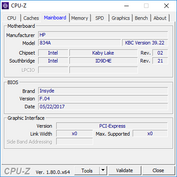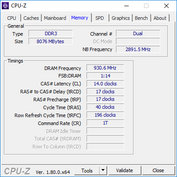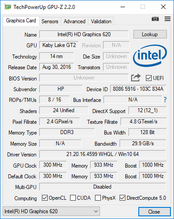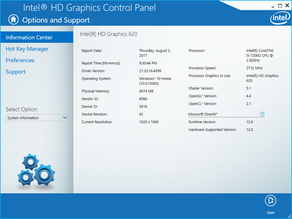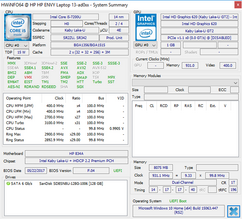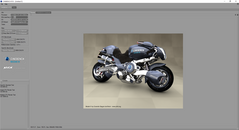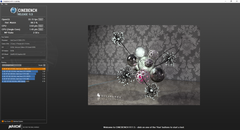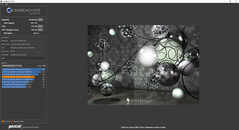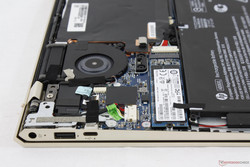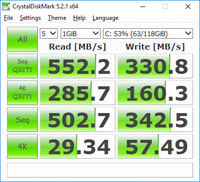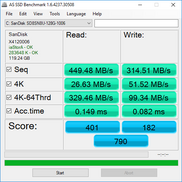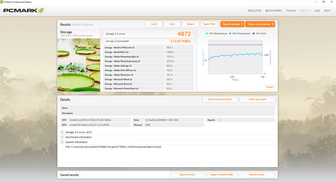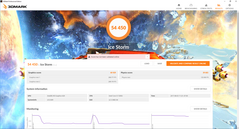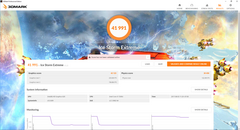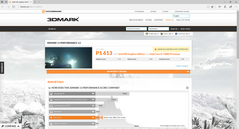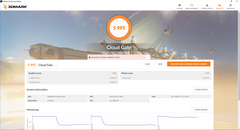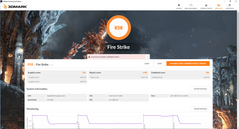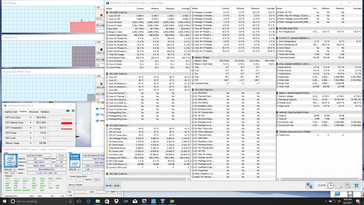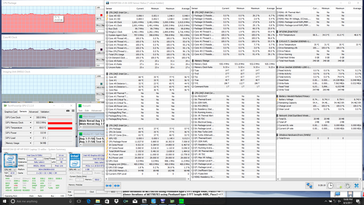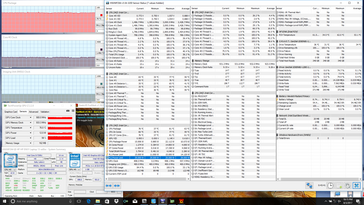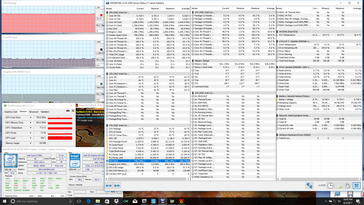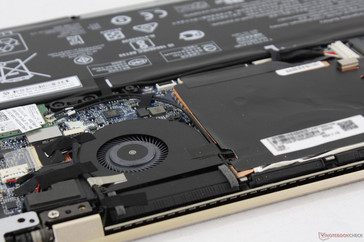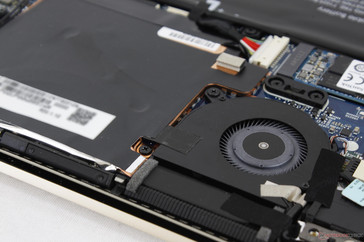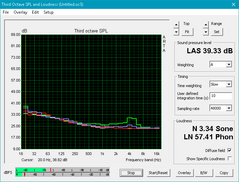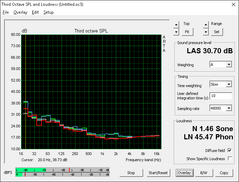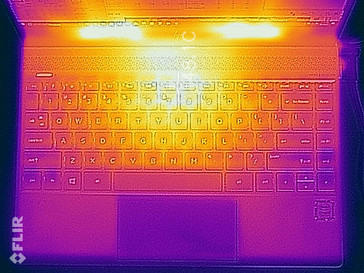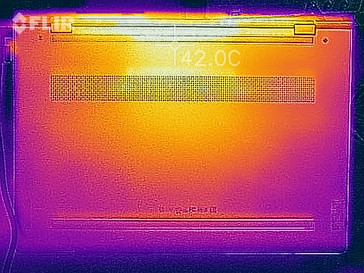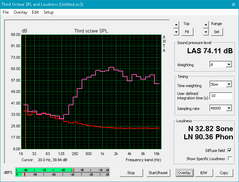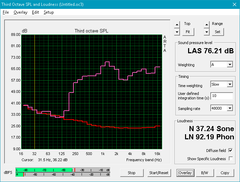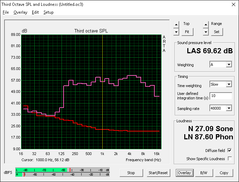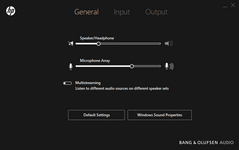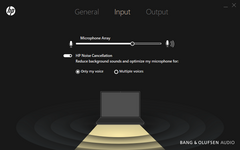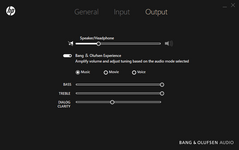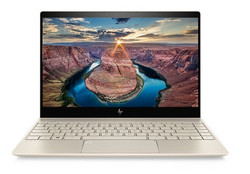HP Envy 13 ad065nr (i5-7200U, FHD) Laptop Review

The XPS 13 is arguably the 13-inch Windows subnotebook to beat. Its InfinityEdge design came at a time when narrow bezels were uncommon and Dell still managed to knock it out of the park. Ever since then, the number of competing narrow bezel designs has been growing and the new Envy 13 is the latest example from HP.
Called "Micro Edge", HP's first take on narrow bezels was on the higher-end Spectre x360 series that was good enough to win "Best Windows Laptop of 2016" from The Verge. The design has now been passed down to the mainstream Envy family for the first time to better compete against the XPS 13, Zenbook UX3430, Samsung Notebook 9, and other emerging narrow bezel designs. Its a brand new Envy design that should feel instantly familiar to owners of the latest Spectre x360 13.
Our 13-inch configuration today houses an i5-7200U CPU, 8 GB of RAM, 128 GB SATA III SSD, and a non-touch 1080p glossy display for a retail price of $840 USD. Higher-end SKUs can be equipped with the faster i7-7500U, 16 GB of RAM, NVMe SSD, and a 4K UHD touchscreen for about $1320 USD. Graphics is limited to the integrated HD Graphics 620 while the larger Envy 15 can be configured with the GeForce 940MX.
We recommend checking out our existing Envy review pages below for more details on the series.
Case
HP is doubling down on the "Lifted hinge" design that continues to be a unique visual feature for both the Envy and newer Pavilion notebooks. The smooth matte aluminum surfaces look nearly identical to the MacBook 12 even down to the two Silk Gold and Natural Silver color options. When compared to the older Envy 13, the redesign is flatter and sharper around the edges and corners for a more minimalist appearance. There's no denying the excellent first impressions after having recently published on a number of budget Pavilion SKUs.
As great as it may look, there are a couple of downsides that hold back the Envy. This is not a unibody design unlike on the MacBook 12 and the inner bezel of the display is thus a cheaper black plastic. The touchscreen SKUs promise edge-to-edge glass that should make the lid feel and look better, but this additional layer of glass will make the notebook a little heavier and likely even glossier than it already is on our non-touchscreen test unit. Attempting to twist the base will result in more bending and audible creaking than an XPS 13 or MacBook 12. Meanwhile, the center of the keyboard will warp slightly when applying pressure with a finger. None of these drawbacks are significant enough to make the notebook feel cheap in any way, but they collectively place the Envy a few steps behind the Dell and Apple in terms of chassis rigidity and robustness.
Perhaps the worst offender of the Envy is still the lifted hinge design. The lid teeters more easily than on the Lenovo Yoga 910 and even the cheaper Pavilion series when first opening the display. This makes the lid feel cheap even though its hinges are otherwise satisfactory up to the maximum angle. The drawback is an inherent disadvantage of the unique lifted hinge design as the newer Pavilions and older Envy units also suffer from more display teetering than usual. Resistance to twists and depressions is otherwise just slightly above average but weaker than that of the lid on the XPS 13.
The chassis is still very good when taken as a whole especially from a visual standpoint. Our test unit exhibits no uneven gaps or manufacturing defects that can be more common on non-unibody notebooks. Nonetheless, the small details above keep the chassis from being excellent.
The latest Envy design is thinner than both the XPS 13 9360 and MacBook Pro 13 without being significantly heavier or lighter. It is, however, slightly thicker than the outgoing Envy 13 by just over 1 mm. As expected, the new narrow bezels naturally make the notebook much smaller in length and width compared to the Spectre 13 and older Envy 13.
Users will be quick to point out that the new Envy 13 is 15 mm wider than the XPS 13. The extended dimension preserves the front-facing camera placement near the top of the screen unlike on the XPS 13 series.
Connectivity
HP is putting a lot of faith in USB Type-C by including two Type-C ports and no HDMI. Instead, users who want video-out will have to purchase USB Type-C to mDP adapters which will surely aggravate a large subset of multimedia users. Two USB Type-A ports are included down from three on the outgoing Envy 13. It would have been neat to have USB Type-C Gen. 2 for faster speeds or even Thunderbolt 3 like on the XPS 13, but HP is reserving such features for its more premium Spectre lineup.
Port positioning is excellent and nearly symmetrical between the left and right edges. All ports are easy to reach and not too close up front where cables are more likely to entangle.
SD Card Reader
The full-size SD reader from the Envy 13 2016 has been dropped in favor of a smaller MicroSD reader. Transfer rates from our Toshiba Exceria Pro UHS SDXC card average about 82 MB/s compared to well over 200 MB/s from a proper full-size SDXC reader. Moving 1 GB worth of images from our test card to desktop takes about 16 seconds.
A fully inserted MicroSD card sits almost flush against the edge for safe transporting. The push-to-eject spring can be troublesome for larger fingers and users should be careful not to send the MicroSD card flying across the room.
| SD Card Reader | |
| average JPG Copy Test (av. of 3 runs) | |
| Dell XPS 15 9560 (i7-7700HQ, UHD) | |
| Dell XPS 13 9360 FHD i5 | |
| HP Envy 13-ad065nr | |
| maximum AS SSD Seq Read Test (1GB) | |
| Dell XPS 15 9560 (i7-7700HQ, UHD) | |
| Dell XPS 13 9360 FHD i5 | |
| HP Envy 13-ad065nr | |
Communication
An Intel 7265 WLAN module with integrated Bluetooth 4.2 is the sole option for the Envy 13. Average transmit speed is slower than expected at 480 Mbps when standing one meter away from our Linksys EA8500 test router, but we otherwise experienced no connectivity issues during our time with the test unit.
| Networking | |
| iperf3 transmit AX12 | |
| HP Spectre 13-v131ng | |
| Dell XPS 13 9360 FHD i5 | |
| HP Envy 13-ad065nr | |
| iperf3 receive AX12 | |
| HP Envy 13-ad065nr | |
| Dell XPS 13 9360 FHD i5 | |
| HP Spectre 13-v131ng | |
Accessories
There are no included extras outside of the warranty card and Quick Start guide. A USB Type-C to RJ-45 or HDMI adapter would have been a great addition especially since these ports were integrated onto the last Envy model.
Maintenance
Serviceability is a little tricky and will require both a T5 Hex wrench and Philips screwdriver. In addition to the four screws around the corners, there are two additional screws hidden underneath the rear rubber footing. Once removed, the bottom panel can be carefully detached around the edges with a sharp edge or plastic card.
HP has revised the motherboard from last year's Envy 13 with new larger fans and a wide copper heat spreader as shown below. RAM is still soldered, but fortunately both the M.2 2280 and M.2 2232 slots continue to be easily accessible.
Warranty
The standard one-year limited warranty applies if purchased directly from HP.com. Options to extend up to three years with accidental damage protection are available for an additional $160 USD.
Please see our Guarantees, Return policies and Warranties FAQ for country-specific information.
Input Devices
Keyboard
The backlit keyboard (~29.3 x 10.3 cm) offers shallower travel and a weaker tactile feedback when compared to the XPS 13 or ThinkPad AccuType series. Keys feel light as a result and could have benefited from more of a "click" when pressed. The plus side is that clatter is minimal for a quieter typing experience and feedback is relatively even across all keys despite the flexible center base.
The gray lettering and bright color of the notebook contrast poorly together. Subsequently, the printing on each key is made more difficult to distinguish than it should be especially when ambient lighting conditions are just right. The keyboard backlight is recommended even if lighting conditions are not unfavorable since it will improve contrast and make the key imprints easier to see. This same issue occurs on certain Spectre notebooks as well and we're disappointed to see it continue here. Furthermore, the keyboard backlight can only be toggled on or off with no brightness options as per usual for HP consumer notebooks.
Touchpad
The integrated trackpad (11.0 x 5.5 cm) is disappointingly smaller than the one on the Spectre x360 13 (12.0 x 6.0 cm) and even the XPS 13 (10.5 x 6.0 cm) in surface area. The short width in particular makes vertical cursor movement feel more cramped than it ought to be. Responsiveness is otherwise excellent from the Synaptics software with no cursor jittering.
The integrated mouse keys have short travel and an adequate tactile feedback when pressed. The main issue is that the trackpad surface can be depressed without the notebook registering an input and so clicking feels spongier than on other flagship Ultrabooks. A firmer trackpad could have definitely improved the experience.
Display
While nothing about the 1080p IPS display has changed on the surface, the panel on the newer Envy 13 is sourced from a different provider than the last. Contrast ratio and color space are thus slightly different - if not a bit worse - than the outgoing Envy 13. Perhaps more notably, the backlight is dimmer than on the previous Envy generation and with poorer uniformity as well; luminance readings becoming increasingly dim when moving from the left side of the screen to the right. The brightness discrepancy isn't significant enough to really notice in practice, but it's a disappointing find nonetheless. Contrast is still excellent and images appear very crisp due to the thin glossy overlay.
Very slight uneven backlight bleeding occurs near the bottom corners of our test unit that is mostly unnoticeable. There are no graininess issues as commonly found on notebooks with matte displays.
Our measurements below reflect only the base FHD non-touchscreen option. SKUs with the FHD touchscreen or 4K UHD touchscreen will very likely exhibit different characteristics.
| |||||||||||||||||||||||||
Brightness Distribution: 78 %
Center on Battery: 290 cd/m²
Contrast: 906:1 (Black: 0.32 cd/m²)
ΔE ColorChecker Calman: 4.8 | ∀{0.5-29.43 Ø4.78}
ΔE Greyscale Calman: 2.8 | ∀{0.09-98 Ø5}
83.5% sRGB (Argyll 1.6.3 3D)
54.9% AdobeRGB 1998 (Argyll 1.6.3 3D)
61.3% AdobeRGB 1998 (Argyll 3D)
83.8% sRGB (Argyll 3D)
65.5% Display P3 (Argyll 3D)
Gamma: 2.19
CCT: 6382 K
| HP Envy 13-ad065nr LG Philips LGD0576, IPS, 13.3", 1920x1080 | Dell XPS 13 9360 FHD i5 Sharp SHP1449 LQ133M1, IPS, 13.3", 1920x1080 | HP Spectre 13-v131ng CMN1374, IPS UWVA, 13.3", 1920x1080 | Apple MacBook Pro 13 2017 APPA033, IPS, 13.3", 2560x1600 | HP Envy 13-d020ng AU Optronics AUO272D, IPS, 13.3", 1920x1080 | |
|---|---|---|---|---|---|
| Display | -19% | 4% | 37% | 5% | |
| Display P3 Coverage (%) | 65.5 | 48.94 -25% | 64.6 -1% | 99.2 51% | 63.7 -3% |
| sRGB Coverage (%) | 83.8 | 73.3 -13% | 88.8 6% | 99.9 19% | 93 11% |
| AdobeRGB 1998 Coverage (%) | 61.3 | 50.5 -18% | 64.8 6% | 87.1 42% | 65.1 6% |
| Response Times | -33% | -56% | -41% | -14% | |
| Response Time Grey 50% / Grey 80% * (ms) | 28 ? | 32.8 ? -17% | 46 ? -64% | 42.8 ? -53% | 34 ? -21% |
| Response Time Black / White * (ms) | 22.4 ? | 33.2 ? -48% | 33 ? -47% | 28.8 ? -29% | 24 ? -7% |
| PWM Frequency (Hz) | 10200 ? | 208 ? | |||
| Screen | -0% | 0% | 46% | 7% | |
| Brightness middle (cd/m²) | 290 | 351.2 21% | 404 39% | 588 103% | 345 19% |
| Brightness (cd/m²) | 270 | 325 20% | 382 41% | 561 108% | 335 24% |
| Brightness Distribution (%) | 78 | 89 14% | 91 17% | 92 18% | 95 22% |
| Black Level * (cd/m²) | 0.32 | 0.195 39% | 0.35 -9% | 0.45 -41% | 0.25 22% |
| Contrast (:1) | 906 | 1801 99% | 1154 27% | 1307 44% | 1380 52% |
| Colorchecker dE 2000 * | 4.8 | 7.4 -54% | 5.37 -12% | 1.7 65% | 4.94 -3% |
| Colorchecker dE 2000 max. * | 11.2 | 9.08 19% | 9.46 16% | 3.5 69% | 8.85 21% |
| Greyscale dE 2000 * | 2.8 | 6.71 -140% | 6.44 -130% | 1.9 32% | 5.85 -109% |
| Gamma | 2.19 100% | 2.74 80% | 2.52 87% | 2.33 94% | 2.25 98% |
| CCT | 6382 102% | 7222 90% | 6738 96% | 6738 96% | 7105 91% |
| Color Space (Percent of AdobeRGB 1998) (%) | 54.9 | 50.48 -8% | 58 6% | 77.92 42% | 60 9% |
| Color Space (Percent of sRGB) (%) | 83.5 | 73.31 -12% | 89 7% | 99.94 20% | 93 11% |
| Total Average (Program / Settings) | -17% /
-8% | -17% /
-7% | 14% /
33% | -1% /
4% |
* ... smaller is better
Color space is wide at approximately 84 percent and 55 percent of sRGB and AdobeRGB, respectively. The Chi Mei and AU Optronics panels on the Spectre 13 and previous generation Envy 13, respectively, have slightly wider gamuts that most users will not likely notice in practice. Users who demand full sRGB coverage may want to consider a notebook with Sharp IGZO options or the Apple MacBook Pro 13 instead. Here's hoping that the 4K UHD SKU is not utilizing RGBW subpixels as did the 2016 Envy 13.
Further measurements with an X-Rite spectrophotometer reveal generally accurate colors and grayscale out of the box. A calibration will improve grayscale even further to a DeltaE value of 1.0, but colors remain largely unchanged. Color accuracy decreases the higher the saturation level due to the panel's imperfect sRGB coverage.
Display Response Times
| ↔ Response Time Black to White | ||
|---|---|---|
| 22.4 ms ... rise ↗ and fall ↘ combined | ↗ 12.4 ms rise | |
| ↘ 10 ms fall | ||
| The screen shows good response rates in our tests, but may be too slow for competitive gamers. In comparison, all tested devices range from 0.1 (minimum) to 240 (maximum) ms. » 49 % of all devices are better. This means that the measured response time is worse than the average of all tested devices (20.2 ms). | ||
| ↔ Response Time 50% Grey to 80% Grey | ||
| 28 ms ... rise ↗ and fall ↘ combined | ↗ 14 ms rise | |
| ↘ 14 ms fall | ||
| The screen shows relatively slow response rates in our tests and may be too slow for gamers. In comparison, all tested devices range from 0.165 (minimum) to 636 (maximum) ms. » 36 % of all devices are better. This means that the measured response time is better than the average of all tested devices (31.6 ms). | ||
Screen Flickering / PWM (Pulse-Width Modulation)
| Screen flickering / PWM detected | 10200 Hz | ≤ 100 % brightness setting | |
The display backlight flickers at 10200 Hz (worst case, e.g., utilizing PWM) Flickering detected at a brightness setting of 100 % and below. There should be no flickering or PWM above this brightness setting. The frequency of 10200 Hz is quite high, so most users sensitive to PWM should not notice any flickering. In comparison: 53 % of all tested devices do not use PWM to dim the display. If PWM was detected, an average of 8101 (minimum: 5 - maximum: 343500) Hz was measured. | |||
Outdoor visibility is below average simply due to how glossy the display is. Glare is prevalent no matter the brightness setting and so users will have to take advantage of the wide IPS viewing angles to make for a more comfortable experience. We absolutely recommend disabling Intel's "Dsiplay Power Saving Technology" in the HD Graphics Control Panel or else the maximum brightness of the display will be reduced to 266 nits on batteries instead of 290 nits when on mains. Users will want the screen to be as bright as possible if working outdoors.
Performance
Users can choose between the ULV i5-7200U or i7-7500U with either 8 GB or 18 GB of onboard DDR3 RAM. It's strange to not see DDR4 especially for a full design refresh in 2017, but then again, HP's higher-end Spectre 13 is still shipping with DDR3 RAM as well. Perhaps more CPU options with integrated Iris Pro graphics like the i7-7660U would have made the Envy 13 even more competitive against the Surface Pro 2017, XPS 13, ZenBook UX310, or MacBook Pro 13. Envy 13 users are stuck with the unimpressive HD Graphics 620 with no GeForce or Iris alternatives.
Processor
The i5-7200U in the HP performs in the same ballpark as other notebooks sporting the same CPU. Raw performance is about 10 to 15 percent over the Skylake i5-6200U depending on load while moving up to the i7-7500U Envy 13 SKU will bring another 10 percent boost according to CineBench benchmarks. Running CineBench Multi-Thread in a loop shows a minimal 6 to 7 percent drop in performance after the 4th or 5th run compared to the massive dips on the latest Surface Pro series.
See our dedicated page on the Core i5-7200U for more technical information and benchmark comparisons.
* ... smaller is better
System Performance
PCMark benchmarks rank the Envy 13 consistently higher than last year's model and even slightly ahead of the XPS 13 9360 despite the latter using a speedier NVMe SSD. Subjectively, system responsiveness is fast as one would expect from an SSD-based notebook with no notable freezes or abnormal behavior during testing.
| PCMark 8 | |
| Home Score Accelerated v2 | |
| Apple MacBook Pro 13 2017 | |
| HP Envy 13-ad065nr | |
| Dell XPS 13 9360 FHD i5 | |
| HP Envy 13-d020ng | |
| Work Score Accelerated v2 | |
| HP Envy 13-ad065nr | |
| Dell XPS 13 9360 FHD i5 | |
| Apple MacBook Pro 13 2017 | |
| HP Envy 13-d020ng | |
| Creative Score Accelerated v2 | |
| Apple MacBook Pro 13 2017 | |
| HP Envy 13-ad065nr | |
| Dell XPS 13 9360 FHD i5 | |
| HP Envy 13-d020ng | |
| PCMark 8 Home Score Accelerated v2 | 3760 points | |
| PCMark 8 Creative Score Accelerated v2 | 4541 points | |
| PCMark 8 Work Score Accelerated v2 | 4669 points | |
| PCMark 10 Score | 3273 points | |
Help | ||
Storage Devices
Like most newer 13-inch Ultrabooks, the single M.2 2280 slot is the only internal storage option on the Envy 13. HP ships SKUs with NVMe support up to 1 TB drives even though our lower-end configuration utilizes a SATA III SanDisk X400 SSD instead. Sequential read and write rates are about average for a SATA III SSD at 449 MB/s and 314 MB/s, respectively, whereas NVMe solutions can reach well over four digits. This particular 128 GB SanDisk SSD is not a significant improvement over the 256 GB Samsung MZRPC256HADR SSD on our older Envy 13 test unit.
See our table of SSDs and HDDs for more benchmark comparisons.
| HP Envy 13-ad065nr SanDisk X400 SD8SN8U-128G-1006 | Dell XPS 13 9360 FHD i5 Toshiba NVMe THNSN5256GPUK | HP Spectre 13-v131ng Samsung PM961 NVMe MZVLW512HMJP | HP Spectre x360 13-ac033dx Samsung PM961 NVMe MZVLW512HMJP | HP Envy 13-d020ng Samsung MZRPC256HADR-000SO | |
|---|---|---|---|---|---|
| AS SSD | 82% | 275% | 283% | 26% | |
| Copy Game MB/s (MB/s) | 162.9 | 390 139% | 397.9 144% | 1123 589% | 196 20% |
| Copy Program MB/s (MB/s) | 99.3 | 188 89% | 426 329% | 466.7 370% | 122.6 23% |
| Copy ISO MB/s (MB/s) | 247.3 | 283.3 15% | 720 191% | 1672 576% | 252.3 2% |
| Score Total (Points) | 790 | 1607 103% | 3617 358% | 2219 181% | 984 25% |
| Score Write (Points) | 182 | 327 80% | 1115 513% | 832 357% | 325 79% |
| Score Read (Points) | 401 | 870 117% | 1654 312% | 945 136% | 439 9% |
| Access Time Write * (ms) | 0.082 | 0.035 57% | 0.026 68% | 0.031 62% | 0.051 38% |
| Access Time Read * (ms) | 0.149 | 0.055 63% | 0.042 72% | 0.036 76% | 0.145 3% |
| 4K-64 Write (MB/s) | 99.3 | 197.7 99% | 862 768% | 566 470% | 231.6 133% |
| 4K-64 Read (MB/s) | 329.5 | 723 119% | 1465 345% | 641 95% | 364.5 11% |
| 4K Write (MB/s) | 51.5 | 92 79% | 134.4 161% | 118.5 130% | 67.5 31% |
| 4K Read (MB/s) | 26.63 | 29.52 11% | 56.4 112% | 48.18 81% | 24.79 -7% |
| Seq Write (MB/s) | 314.5 | 372.8 19% | 1190 278% | 1476 369% | 258.1 -18% |
| Seq Read (MB/s) | 449.5 | 1179 162% | 1325 195% | 2556 469% | 502 12% |
* ... smaller is better
GPU Performance
The HD Graphics 620 in the HP is consistently slower than on the Lenovo ThinkPad X1 Yoga equipped with the same i5-7200U CPU according to 3DMark benchmarks. Moving up to the Iris Graphics 640 or the GeForce 940MX found on certain Ultrabooks will bump raw graphical power by as much as 50 to 70 percent. Gaming performance is similarly anemic.
See our dedicate page on the HD Graphics 620 for more technical information and benchmark comparisons.
| 3DMark 11 Performance | 1613 points | |
| 3DMark Ice Storm Standard Score | 54450 points | |
| 3DMark Cloud Gate Standard Score | 5995 points | |
| 3DMark Fire Strike Score | 858 points | |
| 3DMark Fire Strike Extreme Score | 394 points | |
Help | ||
| low | med. | high | ultra | |
|---|---|---|---|---|
| BioShock Infinite (2013) | 54.3 | 31 | 26.3 | 8 |
| Rise of the Tomb Raider (2016) | 19.9 | 10.9 | ||
| Overwatch (2016) | 33.3 | 25 |
Stress Test
We stress the notebook with synthetic benchmarks to identify for any potential throttling or stability issues. With just Prime95 active, the CPU can be observed operating at the maximum rated Turbo Boost of 3.1 GHz until core temperature reaches 77 C after several seconds. Thereafter, both core clock rate and temperature plateau at the more stable 2.7 GHz - 2.8 GHz and 68 C - 71 C ranges, respectively. The Envy 13 is unable to maintain the maximum Turbo Boost clock rate of the i5-7200U for very long as reflected by both our Prime95 and CineBench loop conditions. Nonetheless, the 2.7 to 2.8 GHz range is still above the 2.5 GHz base clock rate of the processor and so at least some Turbo Boost is preserved. The cycling clock rate and core temperature readings is due to the slight pulsing behavior of the system fans as well.
Running both Prime95 and FurMark to stress both the CPU and integrated GPU will heavily throttle the CPU down to just 1.3 GHz in order to maintain a steady core temperature of 71 C. Note that we selected the incorrect gray HWiNFO graph below (Imaging Unit Clock) to represent real-time GPU clock rate; we apologize for the error. Fortunately, the backup GPU-Z window shows the HD Graphics 620 behaving stably throughout the stress tests in the 750 - 900 MHz range.
Running on battery power will not limit CPU or GPU performance. A 3DMark 11 run on batteries returns Physics and Graphics scores of 4221 and 1545 points, respectively, compared to 3966 and 1474 points on mains.
| CPU Clock (GHz) | GPU Clock (MHz) | Average CPU Temperature (°C) | |
| Prime95 Stress | 2.7 - 2.8 | -- | 68 - 71 |
| FurMark Stress | -- | 900 | 76 |
| Prime95 + FurMark Stress | 1.3 | 750 | 71 |
Emissions
System Noise
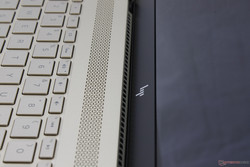
The cooling solution consists of two fans and a copper spreader for the CPU in between. The system is silent during low loads and will impressively remain silent for quite some time even when subjected to higher loads. For example, the fans refused to ramp up until after two full loops of the first 3DMark06 benchmark scene "Return to Proxycon". This is one of the quieter Ultrabooks currently available especially when compared to the more active fans of the thinner Spectre 13 series.
Extreme loads with Prime95 and FurMark will bump fan noise up to a loud 40 dB(A) before quickly falling back to the more tolerable 32 - 33 dB(A) range. Thus, while the fans have the potential to be quite loud, they will not remain at such high RPMs for very long and will throttle accordingly.
An interesting aspect of the fan noise is that it is higher pitched than on other Ultrabooks. Our microphone measurements below show peaks at the 4k Hz mark compared to <2k Hz on the XPS 13, so the fans on the Envy are more noticeable should higher RPMs become necessary. Still, we never found the noise to be distracting during use.
Electronic noise is present on our test unit whenever the internal SSD is actively transferring files. Fortunately, the volume is very low and essentially unnoticeable when under real-world ambient conditions.
Noise level
| Idle |
| 28.1 / 28.1 / 28.1 dB(A) |
| Load |
| 33.3 / 40 dB(A) |
 | ||
30 dB silent 40 dB(A) audible 50 dB(A) loud |
||
min: | ||
| HP Envy 13-ad065nr HD Graphics 620, i5-7200U, SanDisk X400 SD8SN8U-128G-1006 | Dell XPS 13 9360 FHD i5 HD Graphics 620, i5-7200U, Toshiba NVMe THNSN5256GPUK | HP Spectre 13-v131ng HD Graphics 620, i7-7500U, Samsung PM961 NVMe MZVLW512HMJP | Apple MacBook Pro 13 2017 Iris Plus Graphics 640, i5-7360U, Apple SSD AP0128 | Acer Aspire S 13 S5-371-71QZ HD Graphics 520, 6500U, LiteOn CV1-8B512 | HP Envy 13-d020ng HD Graphics 520, 6200U, Samsung MZRPC256HADR-000SO | |
|---|---|---|---|---|---|---|
| Noise | 3% | -9% | -4% | -7% | -9% | |
| off / environment * (dB) | 28.1 | 30.4 -8% | 30.2 -7% | 31.2 -11% | ||
| Idle Minimum * (dB) | 28.1 | 28.9 -3% | 30.4 -8% | 30.2 -7% | 31.2 -11% | 32.5 -16% |
| Idle Average * (dB) | 28.1 | 28.9 -3% | 30.4 -8% | 30.2 -7% | 31.2 -11% | 32.5 -16% |
| Idle Maximum * (dB) | 28.1 | 28.9 -3% | 30.4 -8% | 30.2 -7% | 31.5 -12% | 32.4 -15% |
| Load Average * (dB) | 33.3 | 30.9 7% | 40 -20% | 32.9 1% | 35.7 -7% | 36 -8% |
| Load Maximum * (dB) | 40 | 33.5 16% | 40 -0% | 39.3 2% | 35.8 10% | 36.5 9% |
* ... smaller is better
Temperature
The Envy and Spectre notebooks typically have very symmetrical surface temperature development since they share similar design features. Our temperature maps below show a hot spot of up to 48 C near the center of the notebook closest to the "7" and "8" keyboard keys not unlike on the Spectre 13. While the palm rests remain relatively cool, a good portion of the keyboard can become warmer than on the XPS 13 if under heavy loads. Typing becomes warm but never uncomfortable unless if these center keys are used very frequently.
Surface temperatures are flat during very low loads, but even medium loads with 3DMark06 will warm up the notebook very quickly to the same maximum load temperatures. This is perhaps the price to pay for having fans that are generally very quiet and lethargic.
(-) The maximum temperature on the upper side is 48 °C / 118 F, compared to the average of 35.9 °C / 97 F, ranging from 21.4 to 59 °C for the class Subnotebook.
(±) The bottom heats up to a maximum of 42 °C / 108 F, compared to the average of 39.3 °C / 103 F
(+) In idle usage, the average temperature for the upper side is 28.1 °C / 83 F, compared to the device average of 30.8 °C / 87 F.
(+) The palmrests and touchpad are reaching skin temperature as a maximum (32.2 °C / 90 F) and are therefore not hot.
(-) The average temperature of the palmrest area of similar devices was 28.2 °C / 82.8 F (-4 °C / -7.2 F).
Speakers
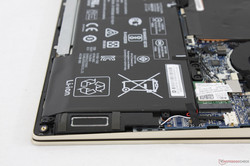
Sound quality from the integrated speakers is decent for a 13-inch Ultrabook. Volume is sufficiently loud and there are no extreme imbalances or static no matter the volume setting. Too loud of a volume (>70 percent), however, and the palm rests will begin to reverberate. Our pink noise measurements show a relatively even reproduction of frequencies similar to the Spectre 13, but bass appears to be slightly worse and with slightly softer maximum volume. Frequencies under 500 Hz drop off more quickly and could have been represented better.
HP Envy 13-ad065nr audio analysis
(-) | not very loud speakers (66 dB)
Bass 100 - 315 Hz
(-) | nearly no bass - on average 20.7% lower than median
(±) | linearity of bass is average (11.1% delta to prev. frequency)
Mids 400 - 2000 Hz
(+) | balanced mids - only 3.4% away from median
(+) | mids are linear (6.3% delta to prev. frequency)
Highs 2 - 16 kHz
(+) | balanced highs - only 1.6% away from median
(+) | highs are linear (6.9% delta to prev. frequency)
Overall 100 - 16.000 Hz
(±) | linearity of overall sound is average (23.7% difference to median)
Compared to same class
» 80% of all tested devices in this class were better, 4% similar, 16% worse
» The best had a delta of 5%, average was 18%, worst was 53%
Compared to all devices tested
» 70% of all tested devices were better, 6% similar, 23% worse
» The best had a delta of 4%, average was 24%, worst was 134%
Apple MacBook 12 (Early 2016) 1.1 GHz audio analysis
(+) | speakers can play relatively loud (83.6 dB)
Bass 100 - 315 Hz
(±) | reduced bass - on average 11.3% lower than median
(±) | linearity of bass is average (14.2% delta to prev. frequency)
Mids 400 - 2000 Hz
(+) | balanced mids - only 2.4% away from median
(+) | mids are linear (5.5% delta to prev. frequency)
Highs 2 - 16 kHz
(+) | balanced highs - only 2% away from median
(+) | highs are linear (4.5% delta to prev. frequency)
Overall 100 - 16.000 Hz
(+) | overall sound is linear (10.2% difference to median)
Compared to same class
» 7% of all tested devices in this class were better, 2% similar, 91% worse
» The best had a delta of 5%, average was 18%, worst was 53%
Compared to all devices tested
» 4% of all tested devices were better, 1% similar, 94% worse
» The best had a delta of 4%, average was 24%, worst was 134%
Frequency Comparison (Checkbox selectable!)
Graph 1: Pink Noise 100% Vol.; Graph 2: Audio off
Energy Management
Power Consumption
The new Envy 13 is more efficient than the older Skylake Envy 13 by a few Watts under all tested conditions. We recorded a power draw of 3 W to 7 W depending on the brightness level and Power Profile when idling on desktop compared to 4 W to 10 W on the Skylake Envy 13. Running 3DMark06 is enough to draw close to the system maximum of about 32 W. The small AC adapter (~6.3 x 6.3 x 3.0 cm) is rated for up to 45 W and so there is ample power headroom even when under extreme processing loads.
Systems with the more capable integrated Iris GPU, such as on certain MacBooks, will demand noticeably more power than our Envy.
| Off / Standby | |
| Idle | |
| Load |
|
Key:
min: | |
| HP Envy 13-ad065nr i5-7200U, HD Graphics 620, SanDisk X400 SD8SN8U-128G-1006, IPS, 1920x1080, 13.3" | Dell XPS 13 9360 FHD i5 i5-7200U, HD Graphics 620, Toshiba NVMe THNSN5256GPUK, IPS, 1920x1080, 13.3" | HP Spectre 13-v131ng i7-7500U, HD Graphics 620, Samsung PM961 NVMe MZVLW512HMJP, IPS UWVA, 1920x1080, 13.3" | Apple MacBook Pro 13 2017 i5-7360U, Iris Plus Graphics 640, Apple SSD AP0128, IPS, 2560x1600, 13.3" | HP Envy 13-d020ng 6200U, HD Graphics 520, Samsung MZRPC256HADR-000SO, IPS, 1920x1080, 13.3" | |
|---|---|---|---|---|---|
| Power Consumption | 8% | -20% | -27% | -30% | |
| Idle Minimum * (Watt) | 2.8 | 4.1 -46% | 3.6 -29% | 3.7 -32% | 4.2 -50% |
| Idle Average * (Watt) | 5.8 | 4.2 28% | 6.4 -10% | 5.2 10% | 7.4 -28% |
| Idle Maximum * (Watt) | 6.4 | 5.1 20% | 9.2 -44% | 7.6 -19% | 10.1 -58% |
| Load Average * (Watt) | 31.3 | 22.1 29% | 34 -9% | 41.6 -33% | 33.4 -7% |
| Load Maximum * (Watt) | 31.7 | 29.4 7% | 34.4 -9% | 50.5 -59% | 34.7 -9% |
* ... smaller is better
Battery Life
HP has upped the battery capacity to 53.6 Wh from 45 W on the outgoing Envy 13 and runtimes have indeed been improved. Users can expect a battery life of over 9 hours on the new Kaby Lake model compared to 6 hours on the older Skylake model when under Balanced WLAN conditions. While still not as impressive as on the XPS 13 or MacBook Pro 13, battery life is still significantly better than even the flagship Spectre 13 since the latter utilizes a much smaller 38 Wh battery. Simply idling on desktop at the lowest possible brightness setting will last for over one full day before automatic shutdown.
Charging from near empty to full capacity will take just over two hours. The system utilizes a proprietary AC port unlike the more standardized USB Type-C charging ports of the Spectre series.
| HP Envy 13-ad065nr i5-7200U, HD Graphics 620, 53.6 Wh | Dell XPS 13 9360 FHD i5 i5-7200U, HD Graphics 620, 60 Wh | HP Spectre 13-v131ng i7-7500U, HD Graphics 620, 38 Wh | Apple MacBook Pro 13 2017 i5-7360U, Iris Plus Graphics 640, 54.5 Wh | Acer Aspire S 13 S5-371-71QZ 6500U, HD Graphics 520, 45 Wh | HP Envy 13-d020ng 6200U, HD Graphics 520, 45 Wh | |
|---|---|---|---|---|---|---|
| Battery runtime | 10% | -40% | -9% | -22% | -33% | |
| Reader / Idle (h) | 24.8 | 21.6 -13% | 12 -52% | 17.1 -31% | ||
| WiFi v1.3 (h) | 9.5 | 11.3 19% | 6.6 -31% | 11.4 20% | 7.9 -17% | 6.4 -33% |
| Load (h) | 2.1 | 2.6 24% | 1.3 -38% | 1.3 -38% | 1.7 -19% |
Pros
Cons
Verdict
The biggest draw of the latest Envy is its lower starting price of $840 USD as a similarly configured XPS 13, Yoga 910, or Spectre x360 13 will run $1000 USD each or more. If Thunderbolt 3 or 2-in-1 features are not desirable, then the Envy 13 makes for a recommendable no frills solution. It's as close to owning a Spectre x360 13 but at a more affordable price point.
While the new chassis is certainly more portable and visually appealing than the outgoing Envy 13, the dropped HDMI port and full-size SD reader may irk some users. Both the keyboard and clickpad could have had better tactile feedback and fan noise, while generally quiet, is higher-pitched than usual. Matte panel and Iris Graphics options would have propelled the Envy 13 to be a more versatile Ultrabook especially for constant travelers or those demanding more graphical horsepower. Investing a couple hundred USD more in the XPS 13 or Spectre x360 13 will still net users sturdier designs, firmer keyboards, and more versatile connectivity options. Thus, the higher-end Envy 13 SKUs are more difficult to justify since the additional processing power is minimal compared to the improved rigidity and quality of the XPS 13 or Spectre designs.
The 2017 Envy 13 is a near-universal improvement over the 2016 model with its larger battery, integrated USB Type-C ports, and smaller and lighter size. It's still a few notches down from the flagship XPS 13 and Spectre series, but its lowest-end SKU still makes for a very strong case against bulky mid-range alternatives.
HP Envy 13-ad065nr
- 08/09/2017 v6 (old)
Allen Ngo




